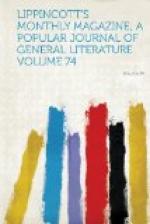With this item of news in fresh remembrance we chanced to read in a very old English newspaper the supper eaten, many years ago, by Mr. Oakley of Stanton, Derbyshire—a repast which makes the Scotchman’s, just recorded, rather frugal by comparison. His first dish, says the report, was two quarts of milk, thirty eggs, half a pound of butter, half a pound of sugar, three penny loaves, a quantity of ginger and nutmeg and an ounce of mustard, all boiled together; his second course was “apiece of cheese and a pound of bread to it;” the third was half a pound of bacon, a penny loaf and a quart of ale, followed by three halfpennies’ worth of ginger-bread and a pint of ale; his fourth dish was a custard of two pounds, an ounce of mustard, some black pepper, a pint of milk and three pints of ale to it. This banquet he finished in an hour, and then ungratefully complained of not having had enough; so, after running three hundred yards by way of appetizer, he sat down with the rest of the company, who had witnessed his prowess, and drank pretty freely. Yet even this exploit is hardly equal to the marvel in digestion reported in the same ancient newspaper of a Truro porter, who, for a bet of five shillings, ate two pairs of worsted stockings fried in train oil, and half a pound of yellow soap into the bargain. The losers of this wager might have been more cautious had they known that the same atrocious glutton once undertook to eat as much tripe as would make himself a jacket with sleeves, and was accordingly measured by a tailor, who regularly cut out the materials, when, to general surprise, the voracious fellow ate up the whole in twenty minutes. Compared with these performances some of the current prodigies of gormandism which the papers so often report are surely as trifling in amount as they are tame and uninventive in the character of their details.
* * * * *
The strange accident of Albertacce brought to general notice an obscure Corsican custom which singularly contrasts with the ordinary funeral ceremonies of Christendom. The vocero, as this rite is styled, is palpably an inheritance from the classical conquerors of the island, now preserved only in some of the interior villages. When the head of a family dies, the body, after being robed in its handsomest garments, is laid in state on a table in the largest room, surrounded with lights. Then, five or six hours before the burial, all the women of the village and the district, clothed in black and with bare heads, assemble around the corpse, the mother and sisters of the dead at the feet, the nearest relations next, and so on. When this assemblage is formed the most renowned poetesses or singers of their number, with hair disheveled and bleeding faces, and a white handkerchief waving in the hand, chant in verse the history, virtues and destiny of the dead. The mournful cadence, the profuse weeping and the dramatic gestures of the ceremony are striking. The chief




